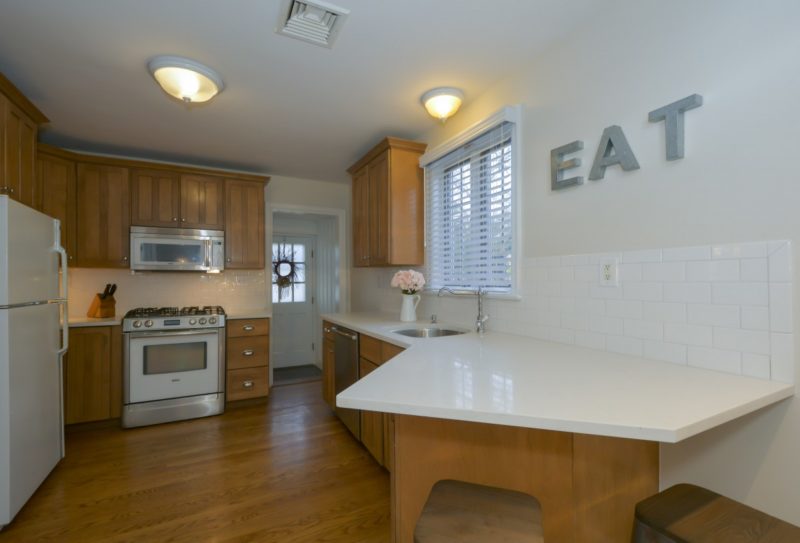Are you about to install a fridge but don’t know how much space should there be between fridge and wall? It should be at least 2 inches. Of course, the area could be more than that, but it should not be less than 2 inches. If you can observe, the back part of your fridge feels warmer than the front side. Well, the back part composes the features that provide your fridge’s interior side with the needed temperature.
So it must be confusing that the components that make cold mist are hotter when they are responsible for the low temperature inside the unit. But that’s just how it works.
Also, you must be curious why it should not be less than 2 inches? There are factors to consider when installing a fridge, such as proper ventilation, which we’re going to discuss soon. So, let’s get on with the topic!
How Much Space There Should Be Between Fridge And Wall
The estimated gap for your fridge is not only decided instantly. We should include certain variables in the computation, and the designated space will prevent severe damage to your unit. You may not comprehend it right now, but you will better understand how your refrigerator works after reading this article.
So, we gathered the possible factors that contribute to how much space should there be between fridge and wall. It’s essential to know these things to understand how to maintain and take care of your refrigerator. And here they are:
Factor #1. Ventilation
The compressor, together with the discharge line, is usually on the bottom back of your fridge. As we mentioned earlier, the back part of your fridge feels warm, and this is because of the compressor. In addition, the discharge lines emit heat, which requires space to depart from the electrical components.
If you leave only an inch of space, your fridge won’t have enough room to breathe or ventilate. The warm air from the compressor will flow back to where it came from, and this will make your fridge overheat. And overheating might cause more severe damage to the whole unit. Your fridge’s lifespan might also decrease rapidly.
Factor #2. Wires
Your fridge will have wires and cables on the back of the unit. It could be for the outlet or to connect to the water supply. So, why are they part of the picture? Well, we don’t want them to tear because of too much bending.
If you leave insufficient space, the wires will become in contact with the wall, and after a couple of months of being bent, they will eventually tear. Once the electrical wires start to tear, it might result in electric shocks or accidents.
Also, pressure on the water line might cause the tubes to disconnect and lead to flooding in your kitchen. Don’t let the wires scatter on the floor. Instead, organize them on the back of your fridge to avoid any accidents. Someone might trip on them and hurt themselves.
Factor #3. Maintenance
It’s necessary to clean the appliances such as refrigerators regularly. So, the gap will give you enough access to sweeping dirt away from the back of the fridge. With this, you can prevent any dirt accumulation on the back cover. Don’t disregard the dust balls or debris stuck to the bottom back of your fridge. They can prevent airflow and proper ventilation. As a result, your fridge will overheat and might not cool properly.
Factor #4. Other appliances in the kitchen
When installing the fridge, you should not place other appliances near the sides or back of your fridge. And don’t plug them into the same outlet at the same time. The power current might not be enough for both of them to share.
Moreover, the heat of other appliances might affect the components of your fridge, especially your compressor. And the temperature from these appliances will put a strain on your unit’s cooling cycle. This situation will reduce the life expectancy of your fridge and make the refrigerator consume more energy.
Factor #5. Space for door to swing and others
So this factor will include the intended space for your door to swing and other stuff in your kitchen. There should be adequate room between the fridge and the countertop side if you have one in the kitchen center. We suggest that the space is more than the width of your fridge door.
Factor #6. Others
Avoid placing the fridge in front of a particular door in your wall. But it’s acceptable if the door swings away from the refrigerator. You might want to imagine what will happen if the door turns towards it. That your fridge door will have plenty of dents and fractures in no time.
And that’s it for our topic: How much space should there be between the fridge and the wall? Regardless, you might be interested in reading about the reasons why does your fridge smell. Then, you can stop by and read this other helpful article.
Closing Insights
And that concludes the article about “How much space should there be between fridge and wall?” As mentioned, it should be at least 2 inches. So, those are the things to think about while installing a refrigerator.
You might want to look from different perspectives and angles. We hope that we addressed your problem and that this article left you with no concerns. Have a great day!

